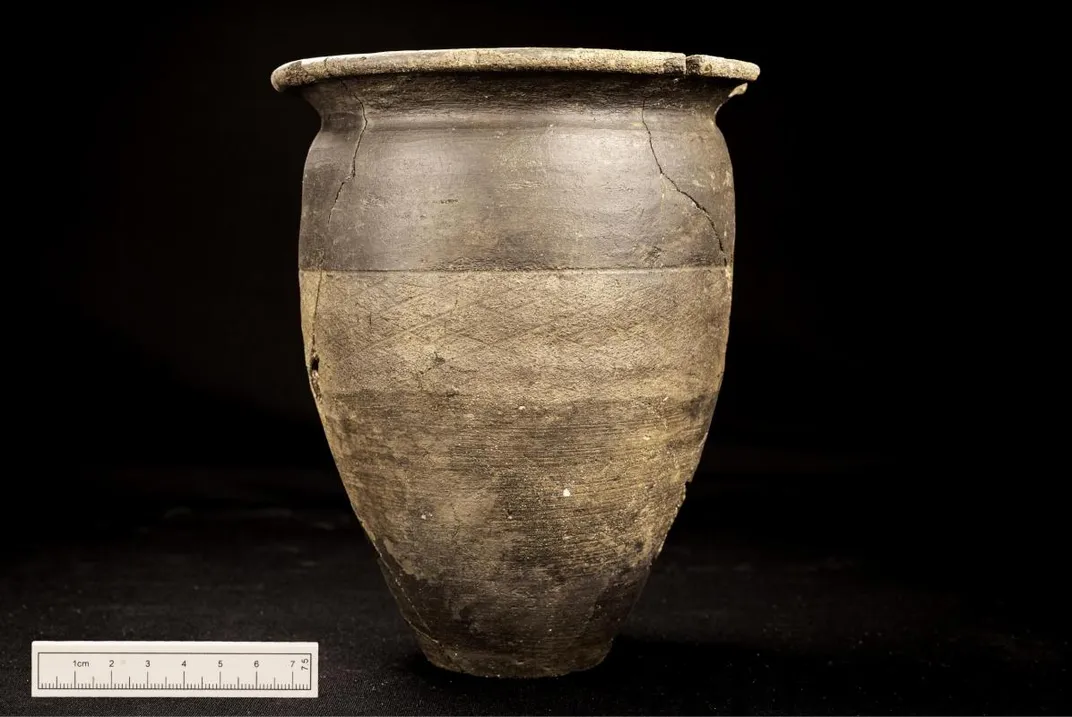High-Status Roman Burials Found in Britain
The discovery provides insight on how Iron Age Britons adopted the Roman lifestyle
/https://tf-cmsv2-smithsonianmag-media.s3.amazonaws.com/filer/f9/d4/f9d4d8ab-a6ba-4e1f-8fb6-657c04b8f07f/jan8-romanbritainskeleton2.jpg)
Archaeologists excavating a site in southwest England ahead of construction of a new school have unearthed an unusual set of 50 Roman era burials.
Per a statement from archaeology firm South West Heritage Trust, the ancient cemetery dates to the Roman occupation of Britain, which took place between 43 and 410 A.D. The graves show the Britons’ progressive adoption of Roman burial practices. Earlier tombs feature bodies laid flat in a small space, while later graves include offerings like coins and a ceramic pot, reports Steven Morris for the Guardian.
The burials’ construction is also notable. Most were lined with stone walls and closed with the same type of flat rock slabs used to make roofs at the time. But one grave has slabs of rock leaned against each other to create a tent-like structure. A similar burial style was previously found 25 miles northwest, according to the Guardian, and both resemble Roman graves seen in Spain and Italy.
“Most graves in Roman Britain are pretty much a rectangular cut with someone laid on their back,” South West Heritage Trust archaeologist Steve Membery tells Morris. “They’ve actually built these graves. There’s been a lot more care taken over these. The individuals were evidently of some status.”
The archaeologists discovered evidence that one older woman was originally buried with her head resting on a pillow. Another grave contained a pot buried with a chicken wing still inside. Additional finds include a carved bone likely used as a knife handle and a coin dating to the reign of Emperor Vespasian, who ruled from 69 to 79 A.D. Nails found at the foot of the graves suggest the adults and children entombed at the site were buried wearing hobnail boots.

Membery says the burials were likely linked with a Roman villa believed to have been nearby. Although the villa has yet to be found, archaeologists have unearthed signs of outhouses and a barn that may be associated with it. According to a separate statement from Wessex Archaeology, the site also yielded traces of Iron Age roundhouses, a Bronze Age barrow and a Roman building.
“Due to the size and lack of disturbance on the site, we have been able to examine generations of a community whose existence spanned over 500 years,” says Damian De Rosa, another archaeologist who worked on the excavations, in the statement. “… What has been particularly fascinating is the cultural transition that we see here—from the native Iron Age traditions to the adoption of more Roman customs.”
The Roman Period began a century after Julius Caesar’s first attempt to conquer the British Isles. As the BBC explains, the Roman invasion was a “war of prestige” designed to secure political power after Caligula’s assassination brought an obscure relative, Claudius, to the throne. The invading army landed in southeast England, pushing north and westward from there. In the southwest, the Romans faced a challenging war of sieges against tribes based out of Iron Age hill forts but soon emerged victorious. In northern regions such as Scotland, however, intermittent rebellion continued throughout the Roman occupation.
Per the BBC, southern Britain was the only place where the landscape “began to look distinctly Mediterranean.”
The BBC concludes, “Towns were built by local gentry, who, in the space of a generation or two, converted themselves from Celtic warriors and druids into Romanised gentlemen.”